Steven O'Connor's Blog
March 30, 2019
I’ve been busy
I’ve been a little invisible on my website. My head has been elsewhere: in my latest work in progress. But at last that project is at a point where I have handed it over to another for their thoughts and reactions. So I have returned to my little website with this quick check-in from me – to let you know I’m still around.
And I have to show you this…

It’s a tidy desk. Hooray! Well, tidy for me anyway. For these are the kinds of things one can do when taking a brief pause in your writing. Watering and weeding the garden is another. My garden has rather suffered. Poor plants.
I have the germ of an idea for my next work-in-progress, which is a nice place to be in, writing-wise. I’ll begin exploring it soon, but in the meantime I’m enjoying spending more time reading. I have finished a book of Neil Gaiman short stories and now begun Haruki Murakami’s latest release, Killing Commendatore.
Well, this is just a quick drop-in. When I have more writing news, I’ll be sure to let you know. Meanwhile, I always like to include a few snaps in my posts, even quick posts such as this. And so I’ve dug around and found a few…
The first two pics are of the Melbourne University buildings where I studied social work many years ago (now a part of Trinity College, apparently). The buildings sit opposite the main campus and I stroll past them each morning on my way to my current social work hospital job. It feels strange seeing them again after so long, and to remember those days in my early twenties. The buildings haven’t changed in the slightest. Even the interiors look the same.
 Melb. Uni’s Social Work Department in the 80s
Melb. Uni’s Social Work Department in the 80s The next building along, where we had our lectures
The next building along, where we had our lecturesAnd so I leave you with some flowers. Though I have been busy, these two have somehow survived and so I’m happy to present them to you now…
 An orchid sitting on my kitchen table right now.
An orchid sitting on my kitchen table right now. And another orchid, this one outside.
And another orchid, this one outside.The post I’ve been busy appeared first on Steven O'Connor: StevenWriting.
August 15, 2017
Seven things about opening sentences

Opening sentences to stories! I can just re-write, re-write and re-write the goddamn things until I go mad. All the while imagining publishers rolling their eyes and tossing the manuscript, written in rivers of my blood, sweat and tears, onto their reject pile. Or, even if you’re lucky enough to have a book published, readers wedging your slaved-over work back onto a bookstore shelf. The thousands of other sentences after that first sentence remaining unread, perhaps for all of time. Opening sentences are such annoyingly important things.
It reminds me a little of something I read a while ago about how on Spotify it’s only after the first 30 seconds of a pop song that an artist gets their teeny weeny royalty. Did you know that? The behaviour even has a name: the shit’n’click habit – deciding something is shit within the first few seconds and clicking on to the next song … and the next … and the next…
Anyway, back to opening sentences. Here are my seven things I reckon are worth thinking about.
The first sentence has to indicate something about what’s to come in the story. That is, set up expectations and raise questions in the reader’s mind, compelling them to want to reader on. What’s this all about, then? I think I’ll sit down and read on to find out.
The first sentence should suggest the genre of the book.
 If it’s written in the first person, the first sentence ought to evoke the character of the protagonist.
If it’s written in the first person, the first sentence ought to evoke the character of the protagonist.It should suggest setting.
It should suggest themes. Growing up, death, life, survival against all odds… Or in the case of Jane Austen, romance, then more romance, then yet more romance… (She really writes about so much more.)
And more than anything else, an opening sentence needs to grab the attention. If you haven’t got this, nothing else matters really.
I don’t know why I said seven? I must have had seven in my head when I began this, but now I can only recall six. Sorry about that! But that’s one less for you to read and think about.
I’m sure there are plenty of other worthy points clever writers have come up with about opening sentences, but these are the ones I’ve come up with off the top of my head, based on stuff I’ve read in the past most likely.
On to something way more fun. Ten opening sentences I happen to like and hope you just might too (whether or not they do any of the above, I’ll let you decide)…
If you really want to hear about it, the first thing you’ll probably want to know is where I was born, and what my lousy childhood was like, and how my parents were occupied and all before they had me, and all that David Copperfield kind of crap, but I don’t feel like going into it, if you want to know the truth. (Catcher in the Rye, JD Sallinger.)
Then there was the bad weather. (Moveable Feast, Ernest Hemingway.)
It was a bright cold day in April, and the clocks were striking thirteen.” (1984, George Orwell.)
“It is a truth universally acknowledged, that a single man in possession of a good fortune, must be in want of a wife.” (Pride and Prejudice, Jane Austen.)
When Mr Bilbo Baggins of Bag End announced that he would shortly be celebrating his eleventy-first birthday with a party of special magnificence, there was much talk and excitement in Hobbiton. (The Lord of the Rings, J.R.R. Tolkien.)

Once upon a time, there was a woman who discovered she had turned into the wrong person. (Back When We Were Grownups, Anne Tyler.)
There was a boy called Eustace Clarence Scrubb, and he almost deserved it. (The Voyage of the Dawn Treader, C.S. Lewis.)
The past is a foreign country; they do things differently there. (The Go-Between, L. P. Hartley.)
Once upon a time in the middle of winter, when the flakes of snow were falling like feathers from the sky, a queen sat sewing at a window framed in black ebony. (Snow-white and the Seven Dwarfs, Brothers Grimm.)
Call me Ishmael. (Moby Dick, Herman Melville. The most famous opening line of all. Three wee words.)
It happened this way. (Monsignor Quixote, Graham Greene. …Ah, there you go, an extra one is on this list.)
As I like to, I’ll leave you with some photos. I had also hoped to share with you my cut-up reworking of Queens’ Bohemian Rhapsody, but that doesn’t seem to be working out just yet. Perhaps I’ll share that with you some other time. Meanwhile, I have seven shots I took of local art while out and about in my local neighbourhood.







The post Seven things about opening sentences appeared first on Steven O'Connor: StevenWriting.
April 30, 2017
Seven things about opening sentences

Opening sentences to stories, I can just re-write, re-write and re-write the goddamn things until I go mad. And while I do, I can’t help imagining publishers flicking their eyes over my painfully wrought-out first sentence, it not immediately grabbing them for whatever reason, and then dropping the whole manuscript, written with blood, sweat and tears, onto the reject pile. And the thousands of other sentences after that first sentence remaining unread. Sigh. Opening sentences, they are such goddamn important things.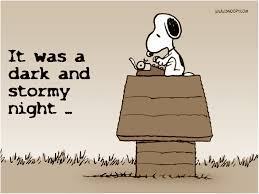
It’s a little like the plight of the pop song in today’s world. On Spotify, the first 30 seconds are critical. Payment doesn’t kick in until after that. Some call this the shit’n’click surfing habit: deciding something is shit within the first few seconds and clicking on to the next song … and the next… and the next…
Opening sentences are hard to write because so much is expected from them. Here are my seven things an opening sentence has to try to do.
The first sentence has to indicate what’s to come in the story. That is, set up all kinds of expectations and raise questions in the reader’s mind, compelling them to want to reader on. What’s this all about? I think I’ll sit down and read on to find out.
The first sentence should suggest the genre of the book.
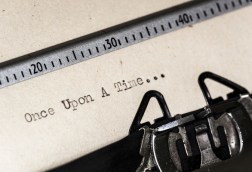 As it’s written in the first person, the first sentence ought to evoke the character of the protagonist (particularly if the story is entirely written from that point of view).
As it’s written in the first person, the first sentence ought to evoke the character of the protagonist (particularly if the story is entirely written from that point of view).It should suggest setting.
It should suggest themes. Growing up, death, life, survival against all odds… Or in the case of Jane Austen, romance, then more romance, then yet more romance… (She really writes about so much more.)
And more than anything else, an opening sentence should be captivating enough to grab your attention.
These are just off the top of my head, based on stuff I’ve read in the past. I’m sure there are plenty of other things.
Onto to something nicer. Ten opening sentences I like. I’ll let you decide if they’re doing any or all of the things I’ve listed above…
If you really want to hear about it, the first thing you’ll probably want to know is where I was born, and what my lousy childhood was like, and how my parents were occupied and all before they had me, and all that David Copperfield kind of crap, but I don’t feel like going into it, if you want to know the truth. (Catcher in the Rye, JD Sallinger.)
Then there was the bad weather. (Moveable Feast, Ernest Hemingway.)
It was a bright cold day in April, and the clocks were striking thirteen.” (1984, George Orwell.)
“It is a truth universally acknowledged, that a single man in possession of a good fortune, must be in want of a wife.” (Pride and Prejudice, Jane Austen.)
When Mr Bilbo Baggins of Bag End announced that he would shortly be celebrating his eleventy-first birthday with a party of special magnificence, there was much talk and excitement in Hobbiton. (The Lord of the Rings, J.R.R. Tolkien.)

Once upon a time, there was a woman who discovered she had turned into the wrong person. (Back When We Were Grownups, Anne Tyler.)
There was a boy called Eustace Clarence Scrubb, and he almost deserved it. (The Voyage of the Dawn Treader, C.S. Lewis.)
The past is a foreign country; they do things differently there. (The Go-Between, L. P. Hartley.)
Today I woke from a thousand-year-old dream and found I was still a boy of 12 going on 13. (Do e-Mice Dream of Electric Running Wheels? This isn’t really one. I just made it up right this second. Sorry! But I kind of like it. Maybe I’ll write the rest of it one day.)
Call me Ishmael. (Moby Dick, Herman Melville. The most famous opening line of all. Three words.)
As always, I want to leave you with some photos. I had also hoped to share with you my cut-up reworking of Queens’ Bohemian Rhapsody, but I’m still working on that. Perhaps I’ll share that with you some other time. Meanwhile, I have seven shots I took of local art while out and about in my local neighbourhood.


[image error]




The post Seven things about opening sentences appeared first on Steven O'Connor: StevenWriting.
November 18, 2016
What Is Social Work Fiction?

Recently, I’ve been reflecting on how my past social work experiences have had an influence on my story writing and I’ve begun to use the term ‘social work fiction’. I quite like it, enough to even include it at the top of my website.
It’s hardly an established genre, obviously nothing like crime fiction, science fiction or literary fiction, but a quick scout around the internet does reveal that the phrase is being used. Well, it’s being used a tiny bit. At any rate, it’s working for me. I think it has a nice easy flow to it. Social work fiction. It almost sounds like an established genre.
So what kind of writing might one expect when referring to something as social work fiction? What fictional ideas or images does the term summon up for potential readers?
A few rather overused social worker images spring to mind. Such as the well-meaning ‘do-gooder’ (I hate that expression, by the way, how did there come to be a derogatory term for people who do good?). She is a woman, probably blonde, young and attractive, and she works at a downtown (read New York) charity of some kind, and she ultimately needs rescuing by a worldly-wise, gritty man. I seem to recall a few 70s films with romantic subplots like this. Probably all starring Clint Eastwood.
And then there’s the other kind of social worker image found in fiction, probably even more common. An older, middle-class woman in a dowdy outfit (perhaps a twin-set outfit, pearls and glasses). She’s a ‘busy body’ – well-meaning (again) but misguided. And she raps on the door of a troubled family’s home only to worsen their plight by attempting to remove the children and place them into the black hole of government foster care.
And I can think of a third kind. A woman again (well, it is a female dominated profession) and she sits silently in a windowless room, watching while two policemen interview a wayward child or teenager.
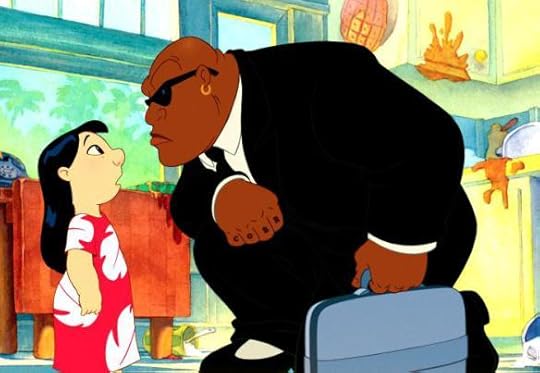
Lilo with Cobra Bubbles (right). I think you’ll agree, he’s not the regular-looking social worker.
Beyond the cliches, there are also some quite oddball representations. Lilo and Stitch is one film that immediately jumps to mind. The social worker is a man for starters (hooray for me), he’s ex-CIA and he goes under the name Cobra Bubbles. But of course, he still wants to place Lilo into foster care. At least he’s a little different to look at.
A social work fiction story with a marvelous difference is the horror flick from 1971, The Baby. This film is bizarre. A social worker investigates the ‘Wadsworth family’ – a mother, two daughters, and an adult son who behaves like a baby. Literally like a baby. ‘Trapped by three women with no way out,’ goes the pitch. The trailer is well worth checking out. It’s on IMDB here.
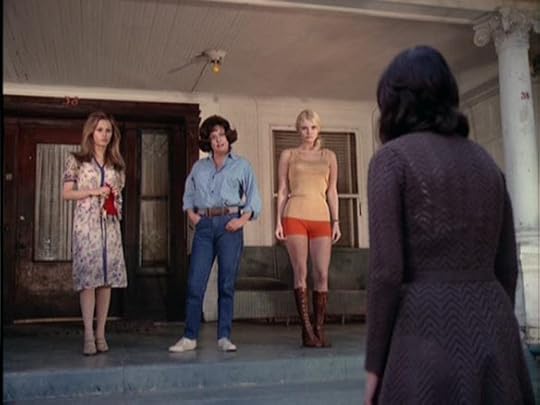
A social worker ‘homevisits’ the Wadsworths.
Happily, recently I’ve witnessed more respectful and inventive portrayals of social worker characters in fiction: competent care workers conducting supportive interventions to create positive change and secure social justice for their clients. But then of course, as drama demands, there’s an upheaval of some kind – a gruesome murder, perhaps – which upturns things and gets the story rolling.
While mostly documentaries, the blog site A Small Good Thing provides an interesting list of 23 powerful films ‘that shed light on social work, social workers, and the important themes and issues that social workers devote themselves to every day’.
Putting all of this to one side, for me, use of the term social work fiction is a personal thing. It’s a way for me to describe what I am writing and something I can fit alongside the more recognisable genre I might be writing in. For example, young adult fantasy. Social work fiction, for me, is a mindset. It’s a part of my writing voice.
So ultimately, that’s what I mean by social work fiction. It’s the lens through which I’m looking at the world I’m creating. For me, social work fiction stories are not just stories that happen to include a social worker in some way.
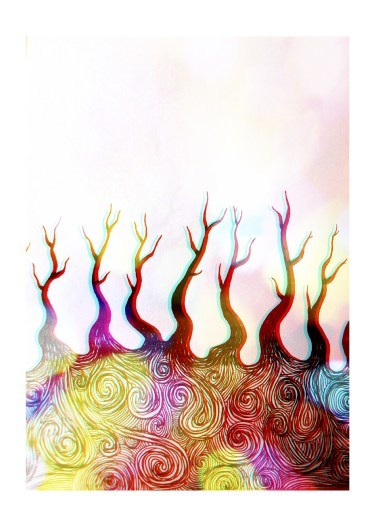
Some play around imagery for Christopher Reuben and the Curious World beneath His Garden.
For example, my latest completed draft novel, Christopher Reuben and the Curious World beneath His Garden, is about a 14-year-old boy with a strange new illness who escapes into an extraordinary world beneath his garden – a world that is under attack by a deadly weed, just as his own body is under attack by a deadly virus. Besides fantasy stories such as Neil Gaiman’s The Graveyard Book (Gaiman’s take on Kipling’s The Jungle Book), Alice in Wonderland and Wizard of Oz, to write the story I drew on the humbling experiences working as a social worker in HIV/AIDS and now cancer.

My traditionally-published sci-fi about a dangerous and highly addictive virtual video game.
In my first, traditionally published book, EleMental, I explore addiction. Set in 2050, a group of kids play a virtual game deliberately designed to be highly addictive (it’s meant for asteroid miners, to prevent them from wanting to go on leave back to Earth). As they play the deadly game, their perceptions of when they are in a game and when they are in the real world because hopelessly blurred until they find themselves trapped in the game world. While writing the story, I draw on my time working with those recovering from alcohol and drug addictions. It’s quite a complex book for a young adult novel.
The latest project I’m still busily working on does happen to feature a social worker. He is the main character, and it’s a novel for adults for a change. Set in the eighties, it’s about a group of social workers (and one in particular) struggling to be effective within the turmoil of a busy infectious diseases hospital that’s caught in the grip of the AIDS epidemic.
My social work identity makes up an important part of my writing voice, no matter what kind of story I end up writing. Sci-fi, fantasy, reality… It’s not deliberate, it’s just a part of me, as your experiences are an important part of you.
***

Led Zeppelin IV
Moving away from social work fiction, as you might have noticed, I have come to enjoy finishing my posts with some cut up lines (drawn from a popular song) and some recent photos.
Firstly, the cut-up lines. As my starting point, I have chosen Led Zeppelin’s Stairway to Heaven from their album Led Zeppelin IV. The resulting lines wound up presenting a different take on spring. A crying lady of birth, death and ascension…
She is Spring
Sometimes I’ve wondered
who makes the light?
who makes the wind?
And at the echo of dawn,
who makes the laughter?
I hear it’s Spring.
She is a brook.
She is a single-note tune.
She is whispered meanings.
She is a lady crying.
She’s crying for those of us leaving.
She’s crying for those of us at the wall.
She’s crying
for all the things we’ve known.
She’s the piper, the songbird, the sign.
Pointing heavenwards. She’s the stairway.
Standing, stretching,
she buys the dawn
with her gold.
She is Spring.
***
And some photos. A palm tree that once lived near me…
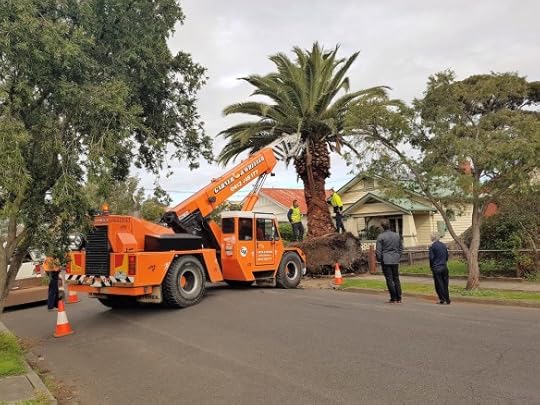
A palm tree down my street is moving out. It’s off to a cafe on the other side of town.
An orchid in my back garden is still going strong. It was a gift to my wife 15 years or more ago…

I water it when I think to. It does the rest.
Lastly, two pics of Robert De Niro’s T-shirt from the fabulous New York, New York film.

Robert De Niro’s T-shirt. (From a Martin Scorsese exhibition I went to recently.)
Here it is, in the film…

Robert De Niro’s T-shirt in context. (With Liza Minnelli.)
So long for now. 
October 16, 2016
What is Social Work Fiction?

Recently, I’ve been reflecting on how my past social work experiences have had an influence on my story writing and I’ve begun to use the term ‘social work fiction’. I quite like it, enough to even include it at the top of my website.
It’s hardly an established genre, obviously nothing like crime fiction, science fiction or literary fiction, but a quick scout around the internet does reveal that the phrase is being used. Well, it’s being used a tiny bit. At any rate, it’s working for me. I think it has a nice easy flow to it. Social work fiction. It almost sounds like an established genre.
So what kind of writing might one expect when referring to something as social work fiction? What fictional ideas or images does the term summon up for potential readers?
A few rather overused social worker images spring to mind. Such as the well-meaning ‘do-gooder’ (I hate that expression, by the way, how did there come to be a derogatory term for people who do good?). She is a woman, probably blonde, young and attractive, and she works at a downtown (read New York) charity of some kind, and she ultimately needs rescuing by a worldly-wise, gritty man. I seem to recall a few 70s films with romantic subplots like this. Probably all starring Clint Eastwood.
And then there’s the other kind of social worker image found in fiction, probably even more common. An older, middle-class woman in a dowdy outfit (perhaps a twin-set outfit, pearls and glasses). She’s a ‘busy body’ – well-meaning (again) but misguided. And she raps on the door of a troubled family’s home only to worsen their plight by attempting to remove the children and place them into the black hole of government foster care.
And I can think of a third kind. A woman again (well, it is a female dominated profession) and she sits silently in a windowless room, watching while two policemen interview a wayward child or teenager.

Lilo with Cobra Bubbles (right). I think you’ll agree, he’s not the regular-looking social worker.
Beyond the cliches, there are also some quite oddball representations. Lilo and Stitch is one film that immediately jumps to mind. The social worker is a man for starters (hooray for me), he’s ex-CIA and he goes under the name Cobra Bubbles. But of course, he still wants to place Lilo into foster care. At least he’s a little different to look at.
A social work fiction story with a marvelous difference is the horror flick from 1971, The Baby. This film is bizarre. A social worker investigates the ‘Wadsworth family’ – a mother, two daughters, and an adult son who behaves like a baby. Literally like a baby. ‘Trapped by three women with no way out,’ goes the pitch. The trailer is well worth checking out. It’s on IMDB here.

A social worker ‘homevisits’ the Wadsworths.
Happily, recently I’ve witnessed more respectful and inventive portrayals of social worker characters in fiction: competent care workers conducting supportive interventions to create positive change and secure social justice for their clients. But then of course, as drama demands, there’s an upheaval of some kind – a gruesome murder, perhaps – which upturns things and gets the story rolling.
While mostly documentaries, the blog site A Small Good Thing provides an interesting list of 23 powerful films ‘that shed light on social work, social workers, and the important themes and issues that social workers devote themselves to every day’.
Putting all of this to one side, for me, use of the term social work fiction is a personal thing. It’s a way for me to describe what I am writing and something I can fit alongside the more recognisable genre I might be writing in. For example, young adult fantasy. Social work fiction, for me, is a mindset. It’s a part of my writing voice.
So ultimately, that’s what I mean by social work fiction. It’s the lens through which I’m looking at the world I’m creating. For me, social work fiction stories are not just stories that happen to include a social worker in some way.

Some play around imagery for Christopher Reuben and the Curious World beneath His Garden.
For example, my latest completed draft novel, Christopher Reuben and the Curious World beneath His Garden, is about a terminally-ill boy who escapes into an extraordinary world beneath his garden – a world that is under attack by a deadly weed, just as his own body is under attack by a deadly virus. Besides fantasy stories such as Neil Gaiman’s The Graveyard Book (Gaiman’s take on Kipling’s The Jungle Book), Alice in Wonderland and Wizard of Oz, to write the story I drew on my years as an HIV/AIDS social worker.

My traditionally-published sci-fi about a dangerous and highly addictive virtual video game.
In my first, traditionally published book, EleMental, I explore addiction. Set in 2050, a group of kids play a virtual game deliberately designed to be highly addictive (it’s meant for asteroid miners, to prevent them from wanting to go on leave back to Earth). As they play the deadly game, their perceptions of when they are in a game and when they are in the real world because hopelessly blurred until they find themselves trapped in the game world. While writing the story, I draw on my time working with those recovering from alcohol and drug addictions. It’s quite a complex book for a young adult novel.
The latest project I’m still busily working on does happen to feature a social worker. He is the main character, and it’s a novel for adults for a change. Set in the eighties, it’s about a group of social workers (and one in particular) struggling to be effective within the turmoil of a busy infectious diseases hospital that’s caught in the grip of the AIDS epidemic.
My social work identity makes up an important part of my writing voice, no matter what kind of story I end up writing. Sci-fi, fantasy, reality… It’s not deliberate, it’s just a part of me, as your experiences are an important part of you.
***

Led Zeppelin IV
Moving away from social work fiction, as you might have noticed, I have come to enjoy finishing my posts with some cut up lines (drawn from a popular song) and some recent photos.
Firstly, the cut-up lines. As my starting point, I have chosen Led Zeppelin’s Stairway to Heaven from their album Led Zeppelin IV. The resulting lines wound up presenting a different take on spring. A crying lady of birth, death and ascension…
She is Spring
Sometimes I’ve wondered
who makes the light?
who makes the wind?
And at the echo of dawn,
who makes the laughter?
I hear it’s Spring.
She is a brook.
She is a single-note tune.
She is whispered meanings.
She is a lady crying.
She’s crying for those of us leaving.
She’s crying for those of us at the wall.
She’s crying
for all the things we’ve known.
She’s the piper, the songbird, the sign.
Pointing heavenwards. She’s the stairway.
Standing, stretching,
she buys the dawn
with her gold.
She is Spring.
***
And some photos. A palm tree that once lived near me…

A palm tree down my street is moving out. It’s off to a cafe on the other side of town.
An orchid in my back garden is still going strong. It was a gift to my wife 15 years or more ago…

I water it when I think to. It does the rest.
Lastly, two pics of Robert De Niro’s T-shirt from the fabulous New York, New York film.

Robert De Niro’s T-shirt. (From a Martin Scorsese exhibition I went to recently.)
Here it is, in the film…

Robert De Niro’s T-shirt in context. (With Liza Minnelli.)
So long for now. 
August 20, 2016
Writing in hotel rooms in other cities

I’d like to tell you about two visits I had last month to a city that is not my own. The visits were to do with my ‘paid job’, but forget about that. I want to focus on my writing in hotel rooms while I was there. Here are some quick and dirty images to kick my post off with. These first ones are a bit bleak…
Sitting in a faceless, outer suburban office tower looking out over a shopping centre car park and stretches of suburbia. Winter. The day is weary from managerial speak loaded with impenetrable agendas.
From the window, I watch cars meandering down white-painted lanes on a concrete shopping centre roof. I can see their near misses as some turn too quickly. From my place above and behind a pane of glass, I have no way of shouting a warning.
High rises sit in the distance, unable to shrug off rain clouds. Later, I travel through a darkness that has fallen too early to a room like every other. I am worn out from earning a living, and I have nothing to talk to but the television. It occurs to me, in some other place, my real life is going on without me.
I jotted those images down upon returning to my hotel room on the night of my first visit. Do they sound gloomy? They probably reflect the mood I was in. The picture at the start of this post is through the office window I was referring to (now via a special effects app I had fun with). Looking at the picture again, yet more gloomy images come to me: the blacks and whites are stark; the clouds are dense.
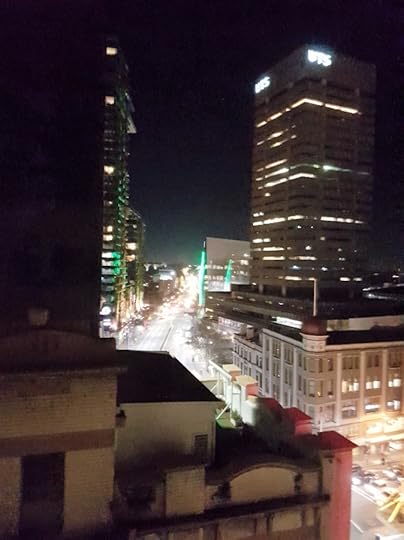
The night view from my CBD hotel window.
The city I visited was Sydney and, to do it justice, it’s a city that could easily be described differently from those images above. Some images that could go with the night view from my hotel window could be: The clouds left, revealing many grades of black and streaks of moving light, a living city.
There’s something in the statement, If you’re a writer, no matter where you are, you’re never alone. You’re always exploring your thoughts and ideas, and looking for ways to describe them. In fact, a hotel room by yourself can be a good thing. You’re free from the many distractions of home. It’s an excellent chance to write. Doubly so if you can’t figure out how to work the TV remote and the music player only has an iPod connector. (Are Apple sponsoring hotels? Not everyone has an iphone.)
And do you know what? I was more productive in those two evenings spent alone in hotel rooms than I’ve been in a long time. I let myself go wherever the pen (keyboard, really) took me. Amongst other things, I found myself exploring characters from my past years working as a hospital social worker and I have begun a new novel based on some of those times – something I hope to tell you about in more detail next time.
Here’s the above window view again, now in the morning…
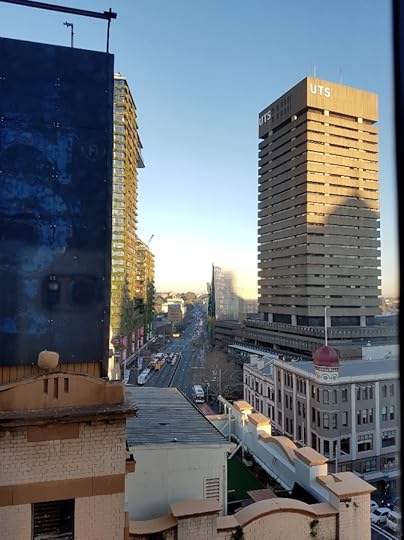
The morning view from the same hotel window.
Some possible written images that strike me for the above: The sun reaches to me through the city, transforming the buildings and long, grey streets with its touch…
Here are some final photos from the second of my two visits. Unlike the first evening, when I stayed in the CBD, this time I was ‘hoteled’ at a place quaintly named called ‘Coogee Bay’. As the rest of my pictures clearly reveal, my visits weren’t all doom and gloom. The light in Coogee Bay glowed. Perhaps it’s always glowing in Coogee Bay…

Coogee Bay at night.
There was something about this house (opposite the hotel) that I liked. Perhaps it was the clothes hanging over the balconies, they were like tears rolling from old eyes… I love the colours in this below picture (of what, I have no idea). The shallow, lapping green, the ocean, deep and quiet, and the night sky with its still clouds…
I love the colours in this below picture (of what, I have no idea). The shallow, lapping green, the ocean, deep and quiet, and the night sky with its still clouds…

I’ve no idea what this is, but it’s located at the far end of Coogee bay.
In honour of the cut-up method that I have come to enjoy toying with, I present a short cut-up piece sourced mostly from the rather dreary text at the top of this post (focussing on those images from the suburban office). I pasted the words into the cut-up machine found here, and selected new images and word strings that appealed to me. It’s rather bleak, as was the source material to begin with.
I, suburbia
Clouds shrugging over
stretches of impenetrable darkness
and faceless windows.
Pale light meandering over parked cars,
lines of houses,
homes.
White-painted illuminated television lives.
We are all – all of us – unable to move.
One final, more cheerful, Coogee Bay pic to leave you with …

Me, in matching shirt and beach.
The post Writing in hotel rooms in other cities appeared first on Steven O'Connor: StevenWriting.
July 25, 2016
Cut up about Bowie

To honour Bowie and the many years of wonderful music he gave us, I’m presenting this post on a songwriting technique he made great use of – the cut-up technique. It’s a method that has intrigued me since I was a teenager and I’ve made use of at different times myself, especially to jumpstart ideas or take an idea further if I can.

The cut-up technique has been around a long time now and was famously used by 60s writers such as William S. Burroughs (Naked Lunch – not something I’ve read, I have to admit), and apparently even earlier by the likes of TS Elliott (Wasteland). I think it was Burroughs who described it as a ‘method for altering reality’.
The method is relatively straightforward and there are lots of opportunities for you to apply your own creative impulses as you go. You simply select some lines of text and cut them up (from as little as one word, for example, to word-strings of about five words), mix them up as much as you like, and then rearrange them into new text, cutting out any bits you feel don’t fit as you go.
Here’s Bowie explaining the process in Cracked Actor, a wonderful 70s BBC doco about him that you might want to check out in full, if you haven’t seen it…
(Just by the by, it was after Nicholas Roeg saw Bowie in this documentary that he decided to approach him for the lead role in The Man Who Fell to Earth. Bowie was exactly the look he was after for his alien.)
Not long after this documentary was aired on TV, I recall reading — in an NME, perhaps — about Bowie assiduously applying the cut up technique during the creation of the incredible Bowie-Eno trilogy of albums Low, Heroes and Lodger. If you check out any one of these albums, you can easily see that the cut-up method was probably used to kickstart many of his song’s lyrics, with their diverse images, including ‘Blackout’, as shown below, from Heroes.
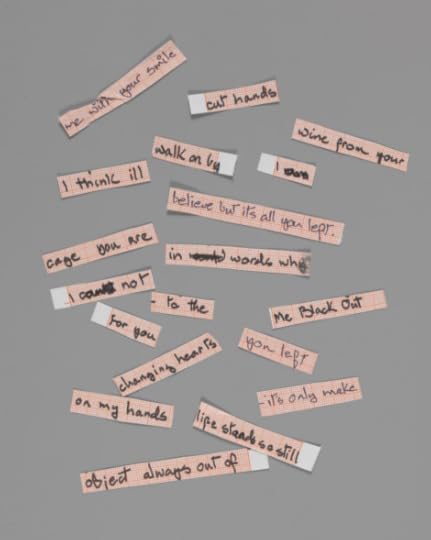
Cut up lyrics for ‘Blackout’. (These were on display at the ‘Bowie Is’ exhibition.)
Bowie went on to co-develop the Verbasizer, an early Mac app which he used to randomly cut up to as many as 20 sentences in one go, to then reassemble as song lyrics. Late last year, I was lucky enough to get along to the extraordinary ‘Bowie Is’ exhibition when it arrived here in Melbourne. Amongst the many costumes and interesting paraphernalia on display, there was also the Verbasizer on an old Mac.
Here he is again, demonstrating it…
‘A technological dream’ — I like that.
Bowie is meant to have written Hallo Spaceboy (from 1995’s Outside, an album produced by Eno, as it happens) with the aid of his Verbasizer. And now, courtesy of the internet, we can all access a version of the Verbasizer to aid us in writing song lyrics, if we so wish. It’s called the Cut Up Machine and it’s right here (but come back, won’t you?).
As a test, I cut and pasted the lyrics to Blackstar (the title and first song on Bowie’s last album) in the Cut Up Machine’s text box field, clicked the cut-it-up button a bunch of times (to really jumble up those words), and then pieced together the following from the block of words the little app spat out. ‘Died Spirit’, below, is what I came up with. (The last line, by the way, came fully intact — very fitting.)
Died Spirit
I’m why you’re the execution.
Died Spirit at the centre.
I’m open-hearted.
But I’m not a smile.
At times I’m of daydreams.
On the day of talking,
I’m upside-down at the centre.
I kneel and take a blackstar.
Just right, an execution star.
A passport to a diamonds place.
I’m bravely solitary.
I’m all yours, I bravely flash.
I’m an angel of want, an angel of all, a solitary star.
A sacred else star.
I kneel at your side.
I died and rose a blackstar.
I quite like it. It’s a cut up about Bowie dying created entirely with his own words and through a creative process he often employed.
I also tried the cut-up method in the more traditional, manual style, jumbling the text up on a page in front of me. For the original text source, I took the last line of every last song from Bowie’s studio albums (because, what the hell, I just thought that would be an interesting thing to do). The end result feels less random and less original in its imagery than ‘Died Spirit’ above. It’s as if, though I tried to be random, because I was more involved in the cut-up process, more of Bowie’s original images survived. It feels less successful than when I utilised the Verbasiser-like app, but I still quite like it. Anyway, here it is…
Knows what the noise can do
In this rain
dies softly a supergod.
Failing star.
It's up to you and me,
to get our feet back.
To shake it up.
To move it up.
We're no strangers
and it's no game.
The last of the dreamers.
Alive or dead.
The last wild kiss me goodbye
knows what the noise can do
king.
I don't want knowledge.
I want certainty.
I want the bloody obscene.
Gimme your hands.
Gimme your hands.
Cause you're wonderful.
And so, at last, a final few words from Bowie on songwriting…
‘…it’s the realization, to me at least, that I’m most comfortable with a sense of fragmentation … The idea of tidy endings or beginnings seems too absolute. It’s not at all like real life.’
–David Bowie
And some final pictures…

David Bowie with William Burroughs, February 1974.
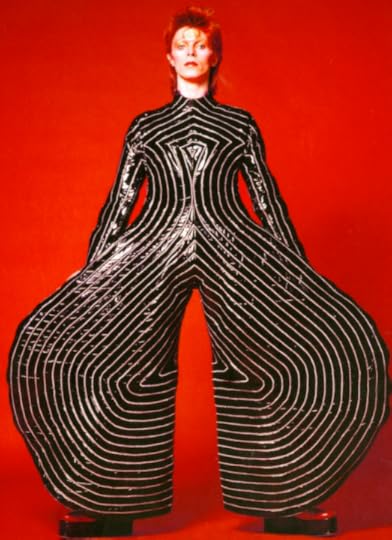
Aladdin Sane period, 1973.

A shot from the ‘Bowie Is’ exhibition.
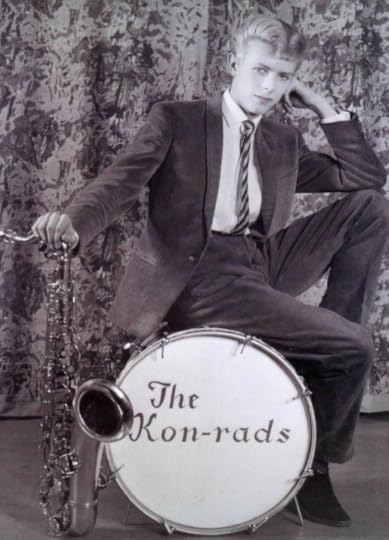
Bowie, 1966. This has been a favourite shot of mine for a long time.
The post Cut up about Bowie appeared first on Steven O'Connor: StevenWriting.
January 25, 2016
Cut up about Bowie dying

Many of us the world over are cut up about Bowie’s death, and as such there have been many beautifully written tributes arriving daily on the internet. And maybe soon some of us will also begin asking, Is he really dead? It all felt so well orchestrated. Maybe he isn’t dead at all?
That’s not a loopy question! Many of us have lived with Bowie all of our lives. Disbelief is a normal part of letting go. I would like to think he is still around somewhere. It’s hard to imagine the world without him, the great musician, the artist and the innovator. All I can say is, I’m so very glad I managed to make it to at least one of his concerts (not so easy, when you live down under), and last year I was also lucky enough to see David Bowie’s long-time producer, Tony Visconti, deliver an excellent tribute concert of the classic The Man Who Sold the World in London. And I now know, while Tony Visconti was performing on stage with many terrific musicians at the Shepherd’s Bush Empire, he was actually aware Bowie was dying.
To honour Bowie, and the many great years of music he has given so many of us, I’d like to write a post focusing on a songwriting technique he made great use of, the cut-up technique. It’s a method that has intrigued me since I was a teenager, and I’ve made use of at different times, especially to jumpstart ideas, or take them further if I can.

The cut-up technique has been around a long time now and was famously used by 60s writers such as William S. Burroughs (Naked Lunch – not something I’ve read, I have to admit), and apparently even earlier by the likes of TS Elliott (Wasteland). I think it was Burroughs who described it as a ‘method for altering reality’.
The method is relatively straightforward and there are lots of opportunities for you to apply your own creative impulses as you go. You simply select some lines of text and cut them up (from as little as one word, for example, to word-strings of about five words), mix them up as much as you like, and then rearrange them into new text, cutting out any bits you feel don’t fit as you go.
Here’s Bowie explaining the process in Cracked Actor, a wonderful 70s BBC doco about him that you might want to check out in full, if you haven’t seen it…
(Just by the by, it was after Nicholas Roeg saw Bowie in this documentary that he decided to approach him for the lead role in The Man Who Fell to Earth. Bowie was exactly the look he was after for his alien.)
Not long after this documentary was aired on TV, I recall reading — in an NME, perhaps — about Bowie assiduously applying the cut up technique during the creation of the incredible Bowie-Eno trilogy of albums Low, Heroes and Lodger. If you check out any one of these albums, you can easily see that the cut-up method was probably used to kickstart many of his song’s lyrics, with their diverse images, including ‘Blackout’, as shown below, from Heroes.
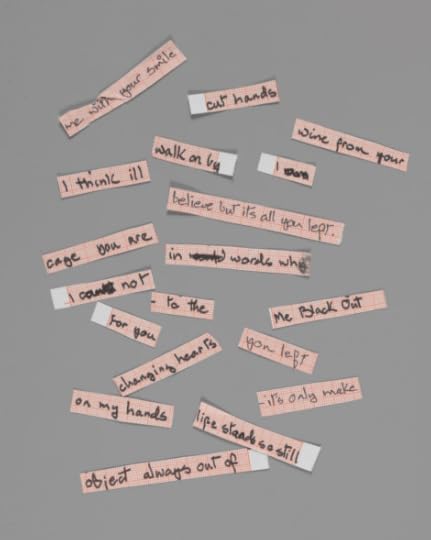
Cut up lyrics for ‘Blackout’. (These were on display at the ‘Bowie Is’ exhibition.)
Bowie went on to co-develop the Verbasizer, an early Mac app which he used to randomly cut up to as many as 20 sentences in one go, to then reassemble as song lyrics. Late last year, I was lucky enough to get along to the extraordinary ‘Bowie Is’ exhibition when it arrived here in Melbourne. Amongst the many costumes and interesting paraphernalia on display, there was also the Verbasizer on an old Mac.
Here he is again, demonstrating it…
‘A technological dream’ — I like that.
Bowie is meant to have written Hallo Spaceboy (from 1995’s Outside, an album produced by Eno, as it happens) with the aid of his Verbasizer. And now, courtesy of the internet, we can all access a version of the Verbasizer to aid us in writing song lyrics, if we so wish. It’s called the Cut Up Machine and it’s right here (but come back, won’t you?).
As a test, I cut and pasted the lyrics to Blackstar (the title and first song on Bowie’s last album) in the Cut Up Machine’s text box field, clicked the cut-it-up button a bunch of times (to really jumble up those words), and then pieced together the following from the block of words the little app spat out. ‘Died Spirit’, below, is what I came up with. (The last line, by the way, came fully intact — very fitting.)
Died Spirit
I’m why you’re the execution.
Died Spirit at the centre.
I’m open-hearted.
But I’m not a smile.
At times I’m of daydreams.
On the day of talking,
I’m upside-down at the centre.
I kneel and take a blackstar.
Just right, an execution star.
A passport to a diamonds place.
I’m bravely solitary.
I’m all yours, I bravely flash.
I’m an angel of want, an angel of all, a solitary star.
A sacred else star.
I kneel at your side.
I died and rose a blackstar.
I quite like it. It’s a cut up about Bowie dying created entirely with his own words and through a creative process he often employed.
I also tried the cut-up method in the more traditional, manual style, jumbling the text up on a page in front of me. For the original text source, I took the last line of every last song from Bowie’s studio albums (because, what the hell, I just thought that would be an interesting thing to do). The end result feels less random and less original in its imagery than ‘Died Spirit’ above. It’s as if, though I tried to be random, because I was more involved in the cut-up process, more of Bowie’s original images survived. It feels less successful than when I utilised the Verbasiser-like app, but I still quite like it. Anyway, here it is…
Knows what the noise can do
In this rain
dies softly a supergod.
Failing star.
It's up to you and me,
to get our feet back.
To shake it up.
To move it up.
We're no strangers
and it's no game.
The last of the dreamers.
Alive or dead.
The last wild kiss me goodbye
knows what the noise can do
king.
I don't want knowledge.
I want certainty.
I want the bloody obscene.
Gimme your hands.
Gimme your hands.
Cause you're wonderful.
And so, at last, a final few words from Bowie on songwriting…
‘…it’s the realization, to me at least, that I’m most comfortable with a sense of fragmentation … The idea of tidy endings or beginnings seems too absolute. It’s not at all like real life.’
–David Bowie
And some final pictures…
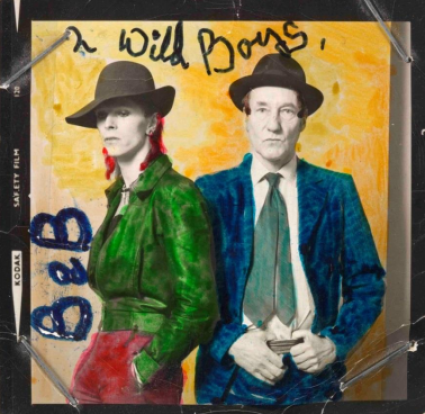
David Bowie with William Burroughs, February 1974.

Aladdin Sane period, 1973.
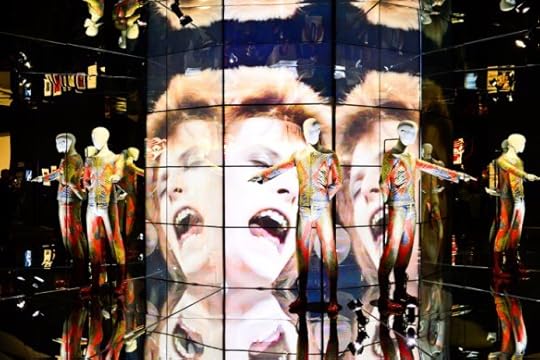
A shot from the ‘Bowie Is’ exhibition.
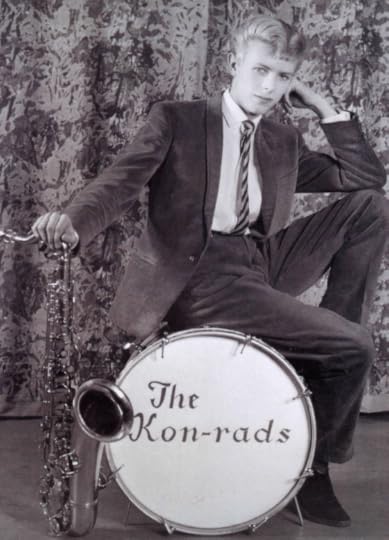
Bowie, 1966. This has been a favourite shot of mine for a long time.
The post Cut up about Bowie dying appeared first on Steven O'Connor: StevenWriting.
January 3, 2016
Novels as fireworks – Structuring my story
It’s always nice to spruce up a blog post with some pictures. Unlike novels, where you have plenty of space for ‘showing’ through words. So above is a shot I took on New Year’s Eve in Melbourne, Australia. A picture of fireworks may not have a lot to do with the topic of story structuring, but read on — I do have a go, as you’ll see — five pics, no less, interpreted as novel structures. And, what-hey, it’s the new year. Fireworks time! Happy New Year.
I’ve been busy structuring a plot outline. That’s a new approach to writing a novel for me. For my first three — EleMental, MonuMental and Beneath the Surface — I began with an idea, some notions around that idea, and then wrote away, seeing where the idea would take me. Roughly 90,000 words later, I’d stop, revise, edit and restructure until I felt I had a completed story in novel form.
This time around, I’m attempting beforehand to lay out as much of the plot as I can, scene by scene, from the novel’s start to its climactic finish and resolution. There’s a risk in this, I know. This kind of intense pre-planning could lead to a predictability. Something I most certainly want to avoid.
When writing ‘organically’ (or to put it more technically, making it up as I go), I’ve less idea where the story is heading. While I may have to cut a fair few things later, it’s a great way to keep the plot twisting and turning in the most unexpected ways.
On the upside, laying the plot out in detail before I begin to write should give me strong, clean lines in the plot. There’s likely to be less risk of confusing the reader. Also, I feel I’ll be able to concentrate on character development. That’s my big hope. In the past, I have striven for balance of plot and character. This time, I want to lay the plot’s tracks down, and then really push the character development as I write. Here’s hoping it works out that way.
I’m keen to get the first draft completed by the end of February. That’s two months of writing. The plot structuring took me a lot longer than I expected — a few weeks instead of a few days. So, given that, heaven knows if I can meet this new goal.
I kicked off this post with a pic of some fireworks, and, for a bit of fun, I’ll close with a few more. (All pics taken with my humble phone camera on New Year’s Eve, 2015.)
So here we go, meeting my promise: five novel plot structures as fireworks (‘novels as fireworks’, I like that notion)…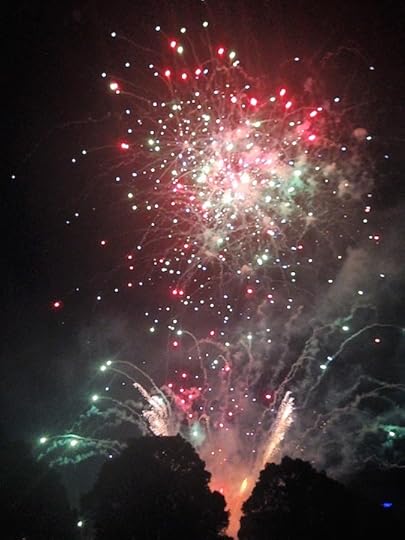
Above: a highly colourful, scattergun approach to laying down a story, with some pretty unexpected stuff happening towards the end…

Above: a single point of view, character-driven story, underpinned with an emphasis on an interesting setting.

Above: a collection of connected short stories woven into one overall plot through a theme of reaching out for unknown things: other worlds, other times, other people. (Phew.)

Above: an explosive romance with multiple points of view — two powerful characters inevitably drawn together, but to what end?

Above: now this is the kind of story I strive for. A strong theme at its heart, a veritable shower of exciting situations, and some extra-big challenges towards the end (in this case, four) — will they survive!
The post Novels as fireworks – Structuring my story appeared first on Steven O'Connor: StevenWriting.
Structuring my story – Novels as fireworks
It’s always nice to spruce up a blog post with some pictures. Unlike novels, where you have plenty of space for ‘showing’ through words. So above is a shot I took on New Year’s Eve in Melbourne, Australia. A picture of fireworks may not have a lot to do with the topic of story structuring, but read on — I do have a go, as you’ll see — five pics, no less, interpreted as novel structures. And, what-hey, it’s the new year. Fireworks time! Happy New Year.
I’ve been busy structuring a plot outline. That’s a new approach to writing a novel for me. For my first three — EleMental, MonuMental and Beneath the Surface — I began with an idea, some notions around that idea, and then wrote away, seeing where the idea would take me. Roughly 90,000 words later, I’d stop, revise, edit and restructure until I felt I had a completed story in novel form.
This time around, I’m attempting beforehand to lay out as much of the plot as I can, scene by scene, from the novel’s start to its climactic finish and resolution. There’s a risk in this, I know. This kind of intense pre-planning could lead to a predictability. Something I most certainly want to avoid.
When writing ‘organically’ (or to put it more technically, making it up as I go), I’ve less idea where the story is heading. While I may have to cut a fair few things later, it’s a great way to keep the plot twisting and turning in the most unexpected ways.
On the upside, laying the plot out in detail before I begin to write should give me strong, clean lines in the plot. There’s likely to be less risk of confusing the reader. Also, I feel I’ll be able to concentrate on character development. That’s my big hope. In the past, I have striven for balance of plot and character. This time, I want to lay the plot’s tracks down, and then really push the character development as I write. Here’s hoping it works out that way.
I’m keen to get the first draft completed by the end of February. That’s two months of writing. The plot structuring took me a lot longer than I expected — a few weeks instead of a few days. So, given that, heaven knows if I can meet this new goal.
I kicked off this post with a pic of some fireworks, and, for a bit of fun, I’ll close with a few more. (All pics taken with my humble phone camera on New Year’s Eve, 2015.)
So here we go, meeting my promise: five novel plot structures as fireworks (‘novels as fireworks’, I like that notion)…
Above: a highly colourful, scattergun approach to laying down a story, with some pretty unexpected stuff happening towards the end…

Above: a single point of view, character-driven story, underpinned with an emphasis on an interesting setting.

Above: a collection of connected short stories woven into one overall plot through a theme of reaching out for unknown things: other worlds, other times, other people. (Phew.)

Above: an explosive romance with multiple points of view — two powerful characters inevitably drawn together, but to what end.

Above: now this is the kind of story I strive for. A strong theme at its heart, a veritable shower of exciting situations, and some extra-big challenges towards the end (in this case, four) — will they survive!
The post Structuring my story – Novels as fireworks appeared first on Steven O'Connor: StevenWriting.




